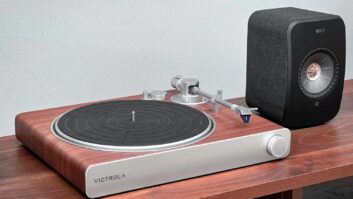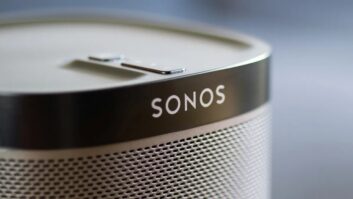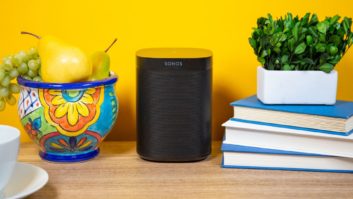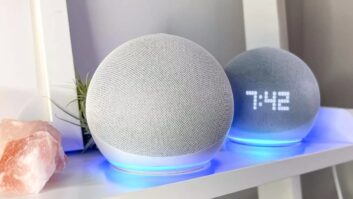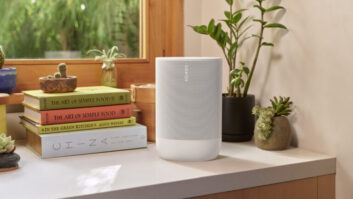
Sonos was alone in the market when it launched the industry’s first Wi-Fi multiroom-audio speakers in 2005, but it’s not alone anymore.
The number of competitors has grown to more than 70 in the U.S., and Amazon and Google have entered the fray with their own Wi-Fi smart speakers, which deliver voice control of various apps and smart-home products and query Cloud-based virtual assistants.
Despite the competitive pressures, Sonos will continue to grow profitably, said Brad Duea, general manager/managing director for the company’s Americas-Pacific region, in an interview at the company’s Boston offices.
Sonos sees “an opportunity for exponential growth in Wi-Fi speakers,” thanks in large part to voice control but also to consumer interest shifting from Bluetooth to Wi-Fi speakers, Duea told TWICE. “Voice is an incredible growth driver,” he said. In addition, “we are through the phase of rapid Bluetooth growth, and interest is shifting from Bluetooth to Wi-Fi.” The Wi-Fi segment [consisting of smart Wi-Fi speakers and traditional Wi-Fi multi-room speakers] “has the greatest growth opportunity compared with Bluetooth.”
See also: Sonos Wants Everyone To Stop Staring At Their Phones
Sonos’ “biggest opportunity” lies in attracting consumers who believe Bluetooth is good enough and people who have complex [home theater] systems where music listening is limited to one room, he said.
“Bluetooth is not a good listening experience,” given Bluetooth’s limited range and interruptions caused by smartphone notifications and incoming calls, he said.
The first wave in wireless-speaker growth arrived when people transitioned from iPod-docking speakers to Bluetooth speakers, and “the next wave is around Wi-Fi-connected smart speakers,” whether via microphone-equipped smart speakers that network with wireless multiroom speakers or via wireless multiroom speakers with their own built-in far-field microphones, he said.
Despite the launches of Amazon’s smart speakers and Google Home multiroom-audio speaker, Sonos sales continue to grow, Duea noted. “In countries where Sonos is present, we are not seeing a negative impact [from the Amazon and Google speakers] on our sales. [And] we are seeing similar growth [in markets] where they have not entered.”
Sometime later this year, Sonos will offer a firmware upgrade that, through “deep custom integration,” will enable Amazon’s Echo, Tap and Dot speakers to stream Cloud-based music services over a Wi-Fi network to Sonos speakers throughout the house. Consumers will also be able to use the Amazon speakers’ microphones to control the play, pause and skip functions of the Amazon services playing through Sonos speakers.
See also: Sonos Founder John MacFarlane Passes Torch To Patrick Spence
But Sonos doesn’t want to stop there. The company eventually wants to use the Amazon speakers to select and control Sonos’ own 80-plus music services, whether through the microphone built into Amazon speakers or through the microphones built into future Sonos speakers that will also access Amazon’s Alexa assistant.
Duea declined to say when Sonos would launch speakers with built-in Alexa access. One current Sonos speaker already features a built-in mic, but it isn’t designed for far-field voice recognition.

Sonos is building dedicated listening rooms in select West Elm home furniture stores.
Here’s what Duea had to say on other topics:
Sales: “We enjoyed double-digit dollar growth in North America and globally in the past quarter,” with one-third of fourth-quarter and calendar-year revenues coming from repeat purchasers in North America and globally, he said. “Once a consumer experiences Sonos, they understand it’s not a one-product purchase. With gifting during the holidays, follow-on purchases come later in the year.”
The company is also posting “strong growth” in the number of households buying their first Sonos product, Duea said.
The addition of a second home theater speaker will also boost Sonos’ sales, driven by Ultra HD TV purchasers who want to improve the TV’s sound quality to match the performance of 4K displays, Duea added.
Newly appointed CEO Patrick Spence called the company “profitable.”
Google Home, Siri, Cortana: Sonos will embrace multiple voice assistants, starting with Amazon’s Alexa, but Sonos will not launch its own voice-control technology. The timetable for supporting other voice services wasn’t disclosed.
Chromecast built-in: “We continue to evaluate it” and its potential impact on the market.
High-res audio: Sonos speakers already support the CD-quality versions of Deezer and Tidal, and “CD quality is what most consumers are interested in.”
Distribution: The company began last fall to roll out Sonos products in all 80 West Elm home-furniture stores, and select stores incorporate dedicated Sonos listening rooms equipped with Sonos products and West Elm home furnishings. The listening rooms are in stores Brooklyn, Manhattan, Boston and Paramus, N.J., with 10 more stores to get the listening rooms at the end of February.
The listening rooms hit a “sweet spot” consisting of consumers “who care about music and the design of their home,” Duea said.
Last fall, Sonos also rolled out its products to Apple’s online store, to
438 Apple stores globally, and to the online Zola.com wedding registry site.





